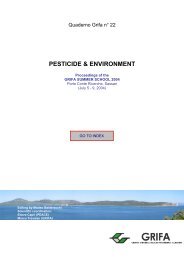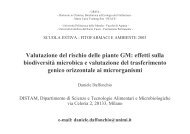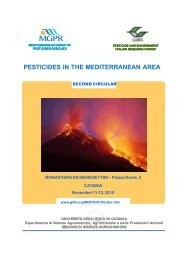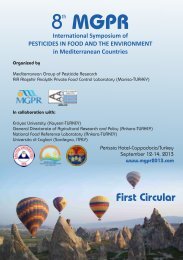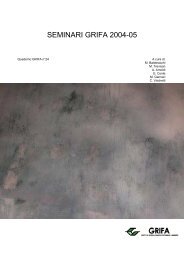International Congress BIOLOGICAL PRODUCTS - Gruppo di ...
International Congress BIOLOGICAL PRODUCTS - Gruppo di ...
International Congress BIOLOGICAL PRODUCTS - Gruppo di ...
You also want an ePaper? Increase the reach of your titles
YUMPU automatically turns print PDFs into web optimized ePapers that Google loves.
33<br />
INVESTIGATIONS ON THE BACTERICIDAL ACTIVITY OF SOME NATURAL <strong>PRODUCTS</strong><br />
Varvaro L., M. Antonelli, G. M. Balestra, A. Fabi, D. Scermino e G. Vuono<br />
Dipartimento <strong>di</strong> Protezione delle Piante, Università degli Stu<strong>di</strong> della Tuscia,<br />
Via S. Camillo de Lellis, 01100, Viterbo, Italy<br />
The Council Regulation (EEC) no. 2092/91 shows the rules on organic production in agriculture to ensure both<br />
consumers and producers. The products for plant protection (copper compounds, propolis and so<strong>di</strong>um silicate) are listed<br />
in the Annex II part B of this regulation. The main chemicals used in organic agriculture to control bacterial plant<br />
<strong>di</strong>seases are cupric compounds. The last EEC Regulation (Reg. no. 473/2002) limits the use of copper and force the<br />
researchers to study new way in controlling bacterial <strong>di</strong>seases. The utilization of natural substances, such as propolis<br />
and so<strong>di</strong>um silicate, is one way susceptible to be investigated in order to better know their bactericidal or bacteriostatic<br />
effect on some host pathogen interactions.<br />
In particular, the activity of propolis and so<strong>di</strong>um silicate, alone or in association with <strong>di</strong>fferent copper<br />
compounds, were in vitro stu<strong>di</strong>ed toward a large number of phytopathogenic bacterial strains, both Gram positive and<br />
Gram negative. Furthermore, some in vivo tests were performed against some bacterial <strong>di</strong>seases of tomato, by spraying<br />
commercial products containing propolis and so<strong>di</strong>um silicate and on hazelnut using copper compounds. In vitro results<br />
show that propolis is active against the growth of the most of Gram positive bacterial strains, even at relatively low<br />
concentrations, while it is very poorly active on almost all essayed Gram negative ones. Antagonistic action of so<strong>di</strong>um<br />
silicate resulted evident only at high concentrations; in particular a certain in vitro inhibition was detected on<br />
Pseudomonas syringae pv. tomato the agent of bacterial speck of tomato, but it was not confirmed by in vivo tests. An<br />
inhibitory effect on epiphytic populations of Xanthomonas vesicatoria, the agent of bacterial spot of tomato, was<br />
observed till to 7 days after the treatment. So<strong>di</strong>um silicate was able to control also epiphytic populations of Clavibacter<br />
michiganensis subsp. michiganensis, the agent of bacterial canker of tomato. The in vitro and in vivo stu<strong>di</strong>es on the<br />
effect of <strong>di</strong>fferent copper compounds in controlling phytopathogenic bacteria showed some interesting results. Copper<br />
oxychloride and new chemicals, like tri-basic copper sulphate or pentahydrate copper sulphate, were sprayed on<br />
hazelnut plants showing <strong>di</strong>eback symptoms. The obtained results confirmed the preventive bactericidal effect of copper<br />
oxychloride against the pathogens and, moreover, pointed out the good effectiveness of the pentahydrate copper<br />
sulphate. In fact, even if this last compound is characterized by a copper concentration five time lower than the copper<br />
oxychloride, and although it has been sprayed at reduced field-doses, it gave the same results in controlling the hazelnut<br />
<strong>di</strong>sease.<br />
All results showed that propolis and so<strong>di</strong>um silicate could be useful in controlling epiphytic bacterial<br />
populations of some phytopathogenic bacteria on tomato, especially in organic agriculture. On the other hand, copper is<br />
confirmed to be used to <strong>di</strong>minish the populations of phytopathogenic bacteria and to reduce in such a way the <strong>di</strong>sease<br />
<strong>di</strong>ffusion. The opportunity to successfully use chemical products characterized by low copper concentration is important<br />
to safeguard the environment and the human health.<br />
PDF creato con FinePrint pdfFactory versione <strong>di</strong>mostrativa http://www.secom.re.it/fineprint<br />
151



